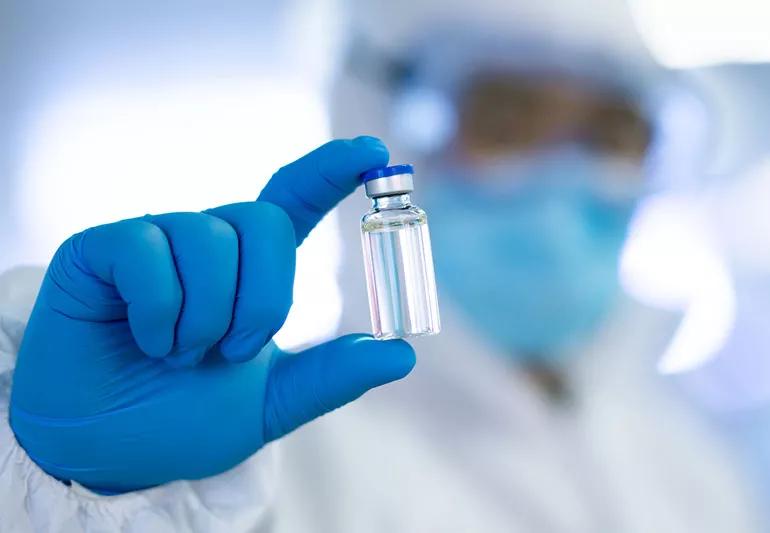Find out more about this experimental anti-viral drug and why we keep hearing so much about it

Since the arrival of COVID-19, the mad dash has been on to discover and develop treatment options to battle this devastating virus. We’ve heard about hydroxychloroquine, antibiotics, and a host of other possibilities. But the one option that seems to keep coming up is an experimental anti-viral drug called remdesivir.
Advertisement
Cleveland Clinic is a non-profit academic medical center. Advertising on our site helps support our mission. We do not endorse non-Cleveland Clinic products or services. Policy
The FDA issued an Emergency Use Authorization for remdesivir at the beginning of May. This means that remdesivir can be distributed in the U.S. and administered intravenously by healthcare providers to treat suspected or laboratory-confirmed cases of COVID-19.
According to the FDA, remdesivir can be used to treat patients who have been hospitalized with severe disease. This includes patients who require oxygen therapy or mechanical ventilators or patients who have inadequate blood oxygen levels.
So where did this drug come from and how does it work? Let’s take a closer look at remdesivir with the help of Pavithra Srinivas, PharmD.
Gilead Sciences began research for remdesivir in 2009 in an effort to find treatment solutions for hepatitis C and respiratory syncytial virus (RSV). The drug was tested against Ebola in 2014. It was also provided for the treatment of a small number of patients under a compassionate treatment protocol during Ebola outbreaks between 2014 and 2016, and again in 2018.
In addition to being tested against Ebola in 2014, remdesivir was tested against other coronaviruses such as SARS and Middle East Respiratory Syndrome (MERS) as well. The manufacturer’s partnership studies with the University of North Carolina and Vanderbilt University showed that remdesivir was active against these coronaviruses with in vitro (outside of a living organism) laboratory tests and in vivo (in a living organism) preclinical animal models. But even though preclinical results were promising, the drug couldn’t progress to clinical studies because there weren’t enough study participants.
Advertisement
With the emergence of COVID-19, the manufacturer decided to test remdesivir against the virus given its performance against other coronaviruses and its ability to interrupt their ability to replicate inside of the body. Based on early data from clinical trials involving COVID-19, the FDA has since authorized the emergency use of remdesivir. This does not mean that it has full FDA approval at this time.
Here’s a breakdown of how remdesivir prevents the coronavirus from invading the body.
In order for a virus to take over, it needs to hijack healthy cells so it can take advantage of their protein-making abilities. When the coronavirus enters the body, it immediately binds to the cells.
Once the virus enters the cells, it releases a strand of viral RNA. This RNA is the genetic code or instructions for making exact copies of the coronavirus.
Ribosomes, or tiny particles in the healthy host cell, will read the virus’ RNA. When the viral RNA passes through a ribosome, the ribosome will start making viral proteins. These proteins are necessary to make more versions of the viral RNA and parts that make up the virus.
As this process repeats, more copies of everything are made. What is produced will eventually come together to form a complete virus. Once formed, this virus will leave the cell it took over and move on to invade other healthy host cells.
Remdesivir has the ability to imitate a part of viral RNA and insert itself into the RNA strand while the virus is making copies of itself. Once this occurs, remdesivir prevents RNA strands from creating the virus’ key parts and blocks the formation of additional copies of the coronavirus. The virus then slows down. Why? Because an incomplete virus is unable to make copies of itself.
Early study results suggest that hospitalized patients who were given remdesivir may experience a faster recovery time compared to those who were given a placebo. While this seems promising, there are still many unknowns.
“Typically a drug has to show both efficacy and safety in rigorous clinical trials, what we call randomized controlled trials, before it can become FDA approved and commercially available for use,” says Dr. Srinivas.
Because of this, remdesivir is still undergoing clinical trials at this time. And until the complete results from these trials are available, the only way to access the drug is through the Emergency Use Authorization protocol.
For now, Gilead has provided its supplies of the medication to the U.S. government, which is working with State Departments of Health to allocate remdesivir to select healthcare facilities under the Emergency Use Authorization protocol.
Advertisement
Advertisement
Learn more about our editorial process.
Advertisement

Covering your mouth when you cough and staying home when you’re sick are a couple ways to help keep yourself and others COVID-free

This vital nutrient supports your health, but its role in COVID-19 prevention and treatment isn’t proven

Studies have shown promising results, but additional research is needed

Infection and inflammation can cause you to lose your voice and have other voice changes until you’re fully healed

A COVID-19 infection can bring on depression or anxiety months after physical symptoms go away

Just like the flu, COVID-19 continues to evolve every year with new and smarter variants

The latest omicron subvariants carry specific mutations that may allow the SARS-CoV-2 virus to be better at evading immune protection

You can work out with mild COVID-19, but not in a gym, and listen to your body and don’t overdo it

If you’re feeling short of breath, sleep can be tough — propping yourself up or sleeping on your side may help

If you fear the unknown or find yourself needing reassurance often, you may identify with this attachment style

If you’re looking to boost your gut health, it’s better to get fiber from whole foods